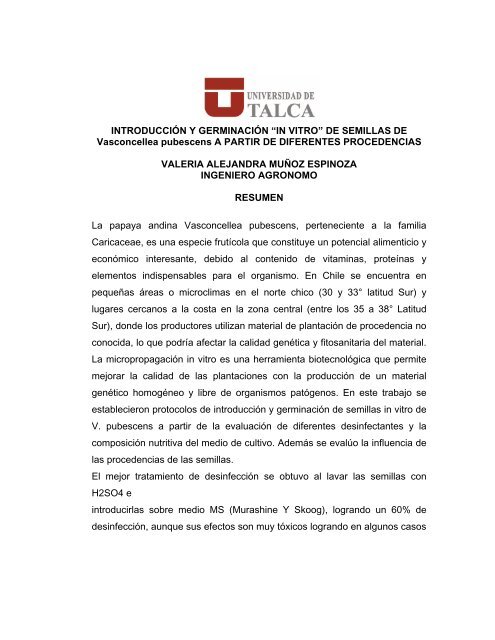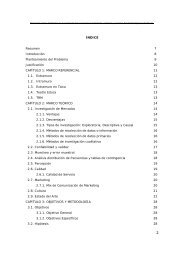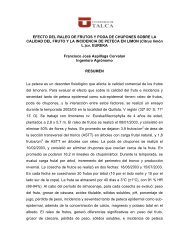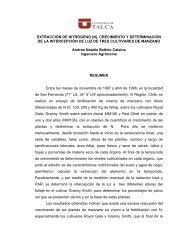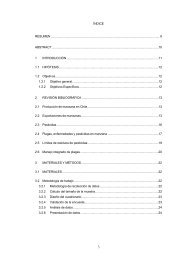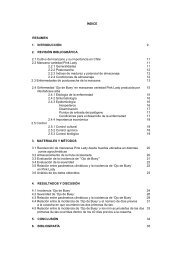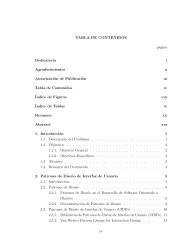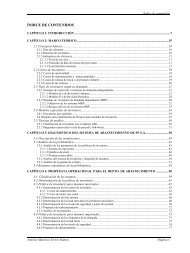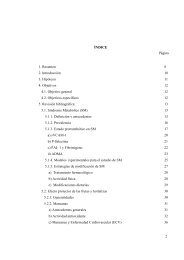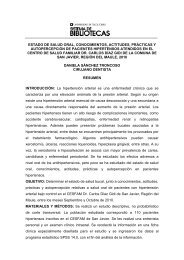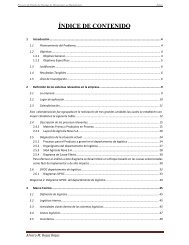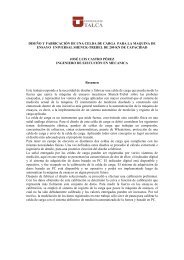INTRODUCCIÓN Y GERMINACIÓN “IN VITRO” DE SEMILLAS DE ...
INTRODUCCIÓN Y GERMINACIÓN “IN VITRO” DE SEMILLAS DE ...
INTRODUCCIÓN Y GERMINACIÓN “IN VITRO” DE SEMILLAS DE ...
You also want an ePaper? Increase the reach of your titles
YUMPU automatically turns print PDFs into web optimized ePapers that Google loves.
<strong>INTRODUCCIÓN</strong> Y <strong>GERMINACIÓN</strong> <strong>“IN</strong> <strong>VITRO”</strong> <strong>DE</strong> <strong>SEMILLAS</strong> <strong>DE</strong>Vasconcellea pubescens A PARTIR <strong>DE</strong> DIFERENTES PROCE<strong>DE</strong>NCIASVALERIA ALEJANDRA MUÑOZ ESPINOZAINGENIERO AGRONOMORESUMENLa papaya andina Vasconcellea pubescens, perteneciente a la familiaCaricaceae, es una especie frutícola que constituye un potencial alimenticio yeconómico interesante, debido al contenido de vitaminas, proteínas yelementos indispensables para el organismo. En Chile se encuentra enpequeñas áreas o microclimas en el norte chico (30 y 33° latitud Sur) ylugares cercanos a la costa en la zona central (entre los 35 a 38° LatitudSur), donde los productores utilizan material de plantación de procedencia noconocida, lo que podría afectar la calidad genética y fitosanitaria del material.La micropropagación in vitro es una herramienta biotecnológica que permitemejorar la calidad de las plantaciones con la producción de un materialgenético homogéneo y libre de organismos patógenos. En este trabajo seestablecieron protocolos de introducción y germinación de semillas in vitro deV. pubescens a partir de la evaluación de diferentes desinfectantes y lacomposición nutritiva del medio de cultivo. Además se evalúo la influencia delas procedencias de las semillas.El mejor tratamiento de desinfección se obtuvo al lavar las semillas conH2SO4 eintroducirlas sobre medio MS (Murashine Y Skoog), logrando un 60% dedesinfección, aunque sus efectos son muy tóxicos logrando en algunos casos
la muerte del embrión. Al lavar las semillas con NaClO y H2O2 e introducirlasen distintos medios y con diferentes concentraciones de GA3, no seencontraron diferencias estadísticamente significativas en la tasa dedesinfección. Se observó una alta influencia de la procedencia de lassemillas sobre la eficiencia de desinfección y la germinación in vitro. Alevaluar distintas procedencias sobre medio MS, se obtuvo como resultadoque las semillas provenientes de Curanipe presentaron una tasa dedesinfección de 96%. La mayor tasa de germinación la obtuvieron lassemillas provenientes de El Sauce, con 0,5% el primer mes y 12% al tercermes. En el medio de cultivo compuesto por MS más GA3 la mejor tasa degerminación se produjo en semillas procedentes de La Serena con 39% elprimer mes. Finalmente, al evaluar la germinación de semillas provenientesde Chovellén se obtuvo como resultado que con los tratamientos 0 o 1 mgL-1de GA3 en el medio MS se obtiene la mayor respuesta germinativa de 30% y33% aproximadamente el primer mes.Las plantas obtenidas presentaban un buen desarrollo fisiológico. Esteprocedimiento de introducción y germinación permitirá el desarrollo deprotocolos de micropropagación de esta especie.Palabras Clave: Micropropagación, Cultivo in vitro, Vasconcellea pubescens
ABSTRACTThe fruit of the Andean papaya Vasconcellea pubescens, Caricaceae, has aninteresting alimentary and economical potencial, due to its content ofvitamins, proteins and essential elements. In Chile it is found in small areas ormicroclimates in the Norte Chico (30 and 33 ° South) and the coast in thecentral zone (35 and 38 ° South), where the farmers use plantation materialsfrom unknown origins, affecting the genetic and phytosanitary quality. One ofthe technological proposals which producers count on is the biotechnologywith the cultivation techniques of vegetable tissues. The micropropagation invitro is a tool that allows to improve the quality of the plantations by theproduction of homogeneous and healthy plant material. In this work protocolsto introduce and germinate seeds of V. pubescens in vitro were establishedassessing the effect of different disinfectants and the nutritional compositionof cultivation media. Besides, the effect of seed origins was evaluated. Thebest disinfection (60%) was obtained by washing seeds with H2SO4 andputting them in on half concentration MS, but in some cases the seeds died.No significant differences were found by washing the seeds with NaClO andH2O2 and putting them in media with different concentrations of GA3. A highinfluence of the seed origins on the disinfection efficiency and the in vitrogermination was observed. Studying the different origins on half concentrationMS, seeds coming from Curanipe showed a disinfection rate of 96%. Thehighest germination rate was found in seeds coming from El Sauce, with0,5% after the first month and 12% the next 3 months. In the cultivate mediumcomposed by MS plus GA3, the best germination rate was produced in seedscoming from La Serena with a 39% after the first month. Finally, when thegermination seeds come from Chevollén. The treatmen 0 or 1 mgl-1 of GA3 inthe half MS showed higherst germinative is with 30% and 33% after duringthe first month. The plants obtained showed a good physiological
development. The present introduction and germination procedure will allowthe development of micropropagation protocols of this species.


